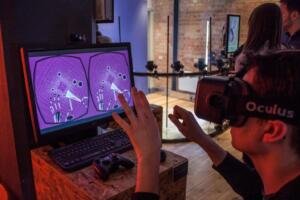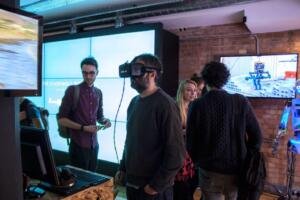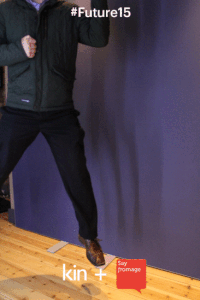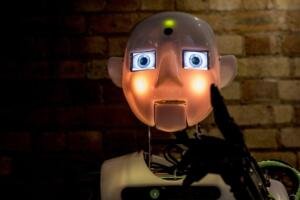
Experiencing London’s Future Tech at Future15
The ongoing love affair with tech across London continues unabated. Future15, a two-week, invite-only pop-up festival of technology and creative content for brand insight, has just wound down, but we were lucky enough to be invited.
Taking place between 9th-20th February at Engage Production’s FLUX Innovation Lounge, one of London’s leading hubs for interactive technology, not far from Leman Street, Future15 was a partnership between Engage, specialists in interactive technology for branded environments and brand design experts Studio Output.
Intended to showcase how marketers can blend creative content and exciting new technology to create greater consumer experiences, Future15 included a packed schedule of talks, workshops and demos offering insights into the latest innovative technology and cutting-edge creative content, and demonstrated how branded content and innovative, interactive technology is revolutionising the way brands, consumers and businesses interact.
Workshops included: Keeping Innovation Innovative; Branding in a Post-digital Age; Making Technology Disappear; The Rise of the Unicorns (where marketing and tech intersect); Life Beyond the Screen (future of visual storytelling); Trends workshops (how multidisciplinary design will grow in 2015).
The latest interactive technologies competed for space, including virtual reality, projection mapping/imaging, Oculus Rift, 3D printing, wearables, interactive robotics, Google Glass, gesture-led tech, touchscreen walls, holograms and much more.
The inspiration arm of Engage, FLUX isn’t new to technology events (we’ve attended previous expos). Intended as a space for creative ideas, where the ‘art of the possible is demonstrated, in action, in order to open the minds of attendees and to encourage debate’, it allows brands and agencies to explore the potential and possibilities of interactive technology. The lounge also offers the chance to network with professionals and industry leaders at fortnightly events, seminars and product launches.

But what tech was demonstrated at this particular event? DisplayMapper, from projection mapping experts ProjectionArtworks, is an impressive retail tech solution to use projection mapping in daylight-visible conditions to transform products in store – in this case, running shoes. A three-way solution – hardware, software and support – DisplayMapper features an advanced 3D geometry mapping engine for advanced projection mapping installations, utilising a PC-based server running Windows, with the unique ability to be reset by SMS or web request from anywhere. Launched summer 2014, it has already featured in London landmark store, Harrods.
Holition showcased an immersive virtual cosmetic experience, Face – the best augmented reality application of its type yet we’ve yet seen. Smartphones and tablet devices act as a ‘mirror’ to allow users to ‘try on’ the latest colours, shades and textures, with highly accurate real-time face tracking.
Holition also showcased it’s mesmorising data visualisation art piece for high-end fashion website Lyst. Visualising the ‘big data’ that Lyst receives, in real time, from its shoppers, around 250,000 items of clothing and accessories are represented on the screen at any one time, allowing popular retail trends to shine through whilst providing an engaging, ingenious and colourful piece of digital art. Useful and visually arresting, we loved it!
Augmented reality was also well represented with applications from DigitalBridge and CImagine, both utilising tablets or smartphones to virtually furnish, decorate rooms. DigitalBridge uses advanced computer-vision technology to allow users to visualise virtual home decorations and furnishings in their own rooms. Users take a photo of their room with tablet or smartphone and DigitalBridge’s Advanced Computer Vision platform converts real-world scenes to digital models, automatically recognising the walls, floors, ceiling, objects and lighting conditions within the room, adjusting accordingly. It produces incredibly realistic, real-world representations of wallpaper, paint colour or sofa coverings – very impressive.
Cimagine allows users to utilise real-time views of their chosen room using the camera function and import items of furniture, pinching to enlarge or reduce until dimensions are accurate. Users can then move towards or around the furniture (although not 360-degrees) to get a sense of how the real product would look. One of the best uses of augmented reality we’ve seen, it is getting a lot of interest from retailers.
 No tech event would be complete without an appearance from Oculus Rift, and Future15 did not disappoint. Funktronic Labs’ Collider combines LEAP Motion with Oculus Rift to present users with an immersive audiovisual experience where they travel through a psychedelic ‘supercollider’ using 3D motion controls and gestures. Developed with games in mind (Funktronic Labs is an LA-based independent games developer), this was one of the best uses of the Rift we’ve yet seen.
No tech event would be complete without an appearance from Oculus Rift, and Future15 did not disappoint. Funktronic Labs’ Collider combines LEAP Motion with Oculus Rift to present users with an immersive audiovisual experience where they travel through a psychedelic ‘supercollider’ using 3D motion controls and gestures. Developed with games in mind (Funktronic Labs is an LA-based independent games developer), this was one of the best uses of the Rift we’ve yet seen.
Almost as much fun, although intended for more practical marketing uses, Cambridge-based tech company Novalia showcased its remarkable interactive paper posters, an innovative way to connect brands to their target audience. Combining conductive print and capacitive touch to create smart surfaces that act as sensors and speakers, Novalia wirelessly connects the digital world to the physical “through the touch of a fingertip”. The interactive paper can either be standalone, or connect to tablet/smartphone apps via Bluetooth. We loved the connected option, which used an app to transform the inner sleeve of a vinyl record into an interactive DJ station.
So how does it work? A circuit is printed onto paper with conductive ink with filled-in areas that act as a capacitive plate, storing electrons. A graphic is printed on top matching up to the capacitive plates, or ‘hotspots’ on the paper and the two are laminated together. When users touch the paper’s ‘hotspots’, electrons are discharged on the other side, and a small printed circuit board (PCB) recognises which hotspot has been activated, responding accordingly. Using regular printing processes, the technology is only a few millimeters thick, lightweight and can be seamlessly integrated into all manner of products without the need for bulky electronics.
Whilst recently featured (in a 360-degree incarnation) on ITV’s X-Factor, Kin’s 180-degree photobooth uses 10 high-quality DSLR cameras and custom timing software to create 180-degree animated gifs of users, in a kind of Matrix ‘bullet time’ effect. The gifs are then uploaded to an online gallery for sharing across social media platforms.

Some of the technology on display at Future15 was geared towards art. A 16th portion of the ‘Discovery Wall’ from art/education/tech specialists Hirsch and Mann looked beautiful. The complete wall is currently housed within Weill Cornell Medical College in New York, and is a long-term, two-year-project ‘art piece’ that is intended to evolve over time as the space changes. Employing 3,800 ipod nano LCD screens with custom optic lenses, it creates multiple images that are only visible close-up, coming together to produce one complete image, visible when viewers stand back.
Also lighting up Future15 was the beautiful egg55, designed by London-based digital designer Moritz Waldemeyer who has designed clothing for Will.I.Am. Designed using Parametric techniques, each individual piece of the egg is flat, but it  becomes a 3D object when assembled in sequence. Hand-made from nickel silver, circuit boards, LEDs and steel rivets, egg55 is completely wireless and is made to order for just over $13,500. A Fabergé egg for the 21st century.
becomes a 3D object when assembled in sequence. Hand-made from nickel silver, circuit boards, LEDs and steel rivets, egg55 is completely wireless and is made to order for just over $13,500. A Fabergé egg for the 21st century.
We also got to play with an amazing interactive wall. Comprising nine 55” LG 9x 55” backlit LED displays combined to create a huge interactive videowall, the wall is overlayed with a PQ Labs infrared touch overlay powered by an Amari server to transform it into a touch surface. Each individual LG display boasts super-thin 3.5mm bezels and LG’s unique proprietary IPS (In Plane Switching) technology. LG’s panel technology ensures accurate colour reproduction, reduced image interruption and class leading viewing angles to provide a truly immersive user experience.
Last but by no means least, RoboThespian from 360Globalnet was fun, scary and impressive! Using gesture recognition to mimic human movements, it replicates how you move, raising its hands and moving its head as you stand transfixed in front of it/him. Also able to be be pre-programmed with speech and movement, it explained all about Future15 before impressing with a variety of famous movie speeches. Acting out with disturbingly accuracy, RoboThespian gave top turns from Jaws, Star Wars, Singing in the Rain, Wizard of Oz, Star Trek and disturbingly of all, Robocop and Terminator!
We’re told that RoboThespian makers 360Globalnet are woking on making him walk, so hopefully he’ll be there to greet us at the next FLUX, before giving us the guided tour! Watch this space…




